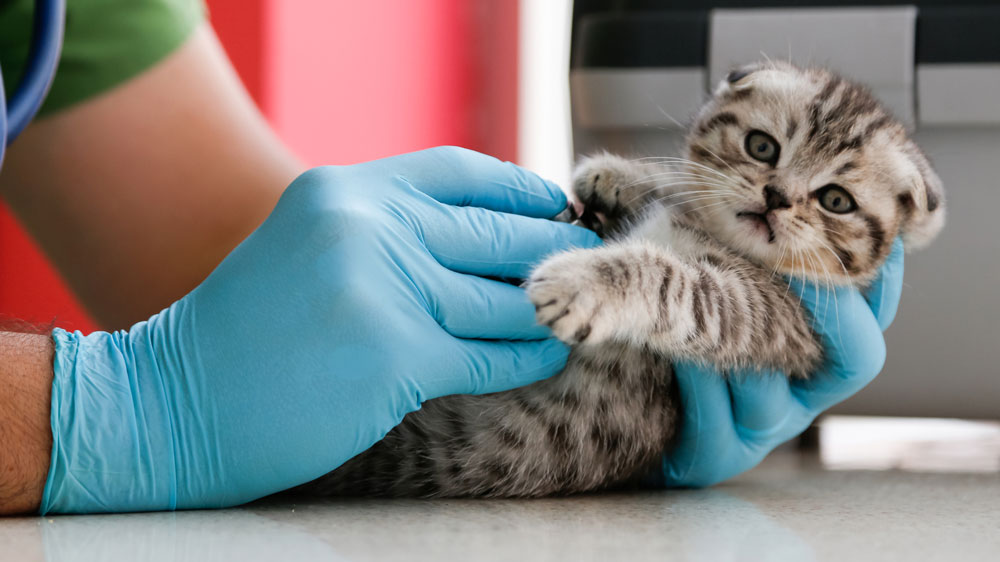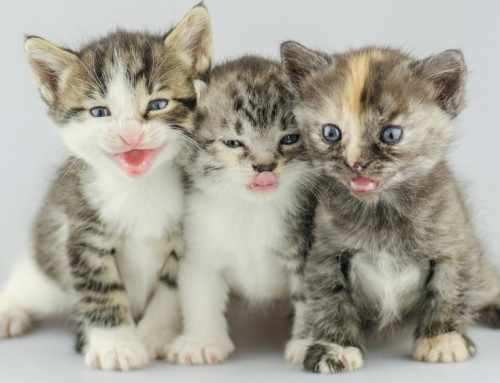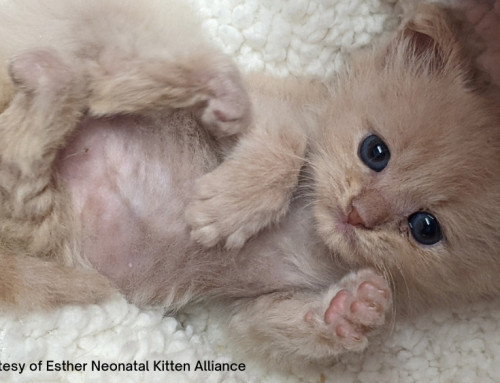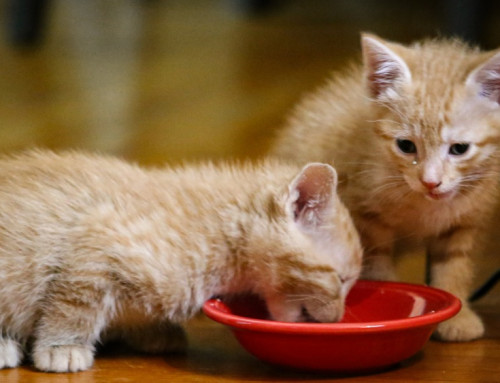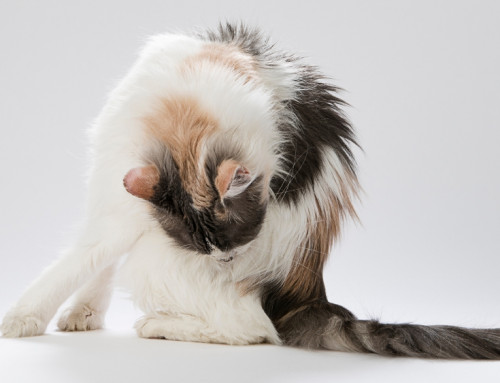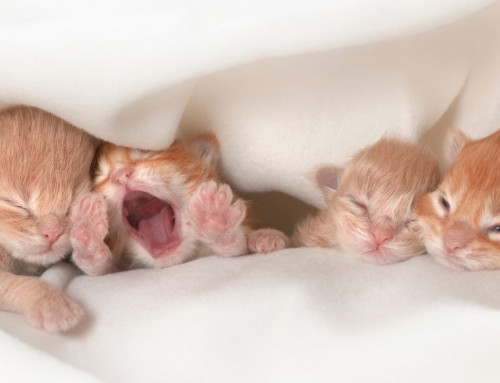Share this resource or email it to a friend!
All kittens should receive a baseline exam to access their overall health status. This allows you to address any immediate concerns as well as measure subsequent improvement or worsening of the kitten’s health. Follow these steps to perform a thorough exam. Remember to talk softly, move slowly and handle gently.
Set up your exam area with all the supplies you’ll need to complete your exam. Make sure they are properly disinfected between each kitten and each litter. Other supplies such as bathing/grooming implements may be useful to have nearby, too. Keep your exam area warm and draft free and preferably in an isolated and escape-proof room.
Get as much medical and husbandry history as possible from the previous caregiver or finder. This history may give critical insights into what needs to be done immediately to stabilize a kitten. For example:
- Where did you find the kitten? On asphalt? In a puddle?
- What was the weather like when you found the kitten?
- How long have you had kitten? Where did you house the kitten? What did you feed the kitten, how much, how often, what dilution? Did you see the queen or littermates?
Now for the patient.
- Weigh the kitten. Use an ounce or gram scale. Tare your scale with whatever towel you are using to cover the top to help keep the kitten warm.
- Take the kitten’s temperature. Use a digital thermometer with a 5-10 second read time. Be sure to lubricate the tip of the thermometer, insert it gently, and disinfect it between uses. A kitten whose temperature is low needs to be warmed immediately.
Start your exam by working your way from the front of the kitten to the back. This is called a “nose to toes” exam.
- Ears: Are they upright or closed? Are there any parasites, dirt, or discharge?
- Eyes: Are they closed or open?
- If they are closed, are they clean? Are they puffy or flat? Is the nictitating membrane (third eyelid) up?
- If they are open, what color are the irises? Are the eyes bulging or sunken back in the sockets? Is there any discharge? Is the kitten squinting?
- Nose: Is there discharge?
- if so, note its consistency and color.
- Is the discharge coming out of one or both nostrils?
- Is the kitten having trouble breathing?
- Mouth:
- Is it clean?
- Is the kitten panting with an open mouth? This could mean the kitten is too hot or having difficulty breathing.
- Are there any teeth? This will help you age the kitten. Check out our Kitten Age chart for more information.
- Is there cleft palate or any lip deformities?
- Gums:
- What is the gum color? Salmon pink is ideal. Pale pink or white may indicate dehydration or anemia. Dark red may indicate infection or high temperature. Blue or purple may indicate anemia, low oxygenation or shock. These are emergencies and require IMMEDIATE veterinary care.
- Do the gums feel slick and smooth, indicating good hydration? Or, do they feel sticky and dry, indicating dehydration?
- What is the capillary refill time (CRT)? Press your finger against the gum line of the kitten until it blanches, and immediately take it away. Count how many seconds it takes for the original color of the gums to return. If it takes more than 2 seconds for the color to return, the kitten is severely dehydrated.
- Chest:
- Is the chest normal or malformed?
- Is the chest rising and falling at an even rate or is the rate erratic? If you have a stethoscope, listen to the heart for an even paced lub-dub sound. Other sounds may indicate a heart problem.
- Do you hear any noise like high-pitched sounds or crackles when listening to the lungs? If yes, this may indicate pneumonia.
- Abdomen:
- When assessed from above, does the kitten look round or skinny?
- When you pick up the kitten underneath the arm pits, does the abdomen look round or pear shaped? Is it hard, squishy, or taut?
- Does the skin on the abdomen and chest look clean and calm? Is it red, inflamed, covered in parasites or sores? Is there a hernia?
- Does the kitten react when the abdomen is touched, indicating possible pain?
- Limbs:
- Can the kitten move appropriately for his/her age (crawl vs. walk)?
- Does the kitten have age-appropriate reflexes like rooting (newborn kittens head for their mother in search of milk) or rolling back on to his/her abdomen, an even gait? Does the kitten wobble or turn in circles? These could indicate a neurological condition.
- When the kitten is held under the armpits upright and slightly suspended, does he pull his back legs up or let them hang loose? Is there a delay in the kitten holding his legs up? Neonatal kittens who are lethargic or weak from hypoglycemia will not pull their hind legs up like when the queen carries them to another location.
- Check the paws and nails. How many toes do they have? Do they need to be trimmed? Do their nails retract? Neonatal kitten’s nails do not retract until they are older, so they will always be exposed.
- Tail: Is it upright and moving or is it limp? Are there any kinks?
- Genitalia:
- Is the kitten male or female? The opening just under the tail is the anus. Below the anus is the genital opening, which is round in males and is a vertical slit in females. The distance between the anus and the genital opening is greater in the male than the female. If a male, are the testes descended?
- Is the anus open and producing feces? Is there blood in the feces? Is the skin clean and calm? Is there urine or feces plaster or scalding?
- Is the kitten producing urine? Use a dry soft piece of toilet paper or tissue to assess by gently stimulating the genitalia area in a rubbing motion. Is there a lot of urine output? What color is it? In neonates, absence of color to pale yellow means good hydration. Darker yellow can mean dehydration. If there is blood or any other color, medical attention is needed.
- Skin:
- Does the skin look clean and calm? Are there any substances on the skin or ticks, fleas, maggots, etc.? Is the coat unkempt or smooth? Are there any wounds or other signs of trauma?
- Demeanor:
- Is the kitten active, vocal, quiet, agitated or non-responsive?
- Does the kitten demonstrate normal age-appropriate movement and behaviors? If not, then medical attention is needed.
Once your exam is complete, you can provide any immediate care to stabilize the kitten. Feeding should only be done once the kitten is warmed and stabilized. Document and address all concerns within your capability, but seek immediate veterinary care for critical concerns you cannot. The kitten’s life may depend on quick action.

